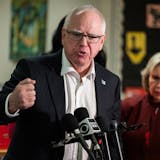Tales of Minnesota exceptionalism are spun so persistently by political and business leaders and news media that, when the state falls really behind on something, it feels pretty shocking.
I’ve felt that shock again and again since writing two columns on child care last month.
The first suggested Minnesota policymakers should consider copying Iowa’s tax breaks for businesses that provide child care. The second suggested the top-down, expensive but effective approach of Finland and other Nordic countries as a model.
Numerous parents, policymakers and experts reached out to let me know I was barely scratching the surface of the problem or the solutions. Some told me about other states that do better than us.
And some said I made a mistake in the first column by writing the phrase “making child care a healthy industry again.” Child care has never been a healthy industry, they said. The perception that it was healthy in the past overlooks that women were providing at relatively low cost when their career options were more limited.
I’m learning more about child care because of the role it can play in bringing more Minnesotans to work. The state’s workforce is constrained by slow population growth and the exit of baby boomers into retirement. With labor force participation already at some of the highest levels in the U.S., Minnesota has to work hard on the margin to make work more attractive or simply possible. Parents of young children are in that margin.
Earlier this month, a few days before the Legislature convened its 2024 session, a handful of state lawmakers, aides to Minnesotans in Congress, child care center inspectors, consultants and others met at Leo Augusta Children’s Academy, a child care center that opened in Blooming Prairie in 2022. They talked about how to extend help for child care to more Minnesotans.
They started with creating a more graduated set of benefits rather than the cutoff that exists when a family’s income exceeds $46,423.

![A black bear stopped after crossing Big Bay Road on Madeline Island, the largest of the Apostle Islands in Wisconsin, on Monday, May 31, 2021. ]](https://arc.stimg.co/startribunemedia/PWNYGIY3WTSWDBOGOYD775DPP4.jpg?&w=80&ar=1:1&fit=crop)

